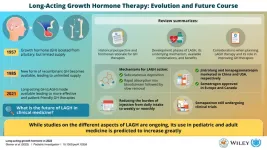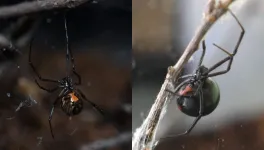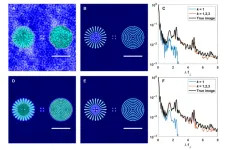(Press-News.org) How strongly a vaccine protects you may depend on getting enough sleep in the days before and after inoculation, finds a new meta-analysis examining the relationship between sleep duration and the body’s response to vaccination.
Sleeping fewer than six hours per night around the time of vaccination was associated with a robust decrease in antibody response, according to the multi-institution study published March 13 in Current Biology. Adults are typically recommended to get between seven and nine hours of sleep per night.
The meta-analysis included data on the association between sleep duration and antibody responses for the influenza and hepatitis vaccines. While comparable data on COVID-19 vaccination were not available, researchers said their study highlighted the need to identify simple behavioral interventions, such as sufficient sleep, that could improve the response to COVID-19 vaccination amid the ongoing pandemic.
The weakened antibody response in those with shortened sleep was so profound, it was similar to the decline in COVID-19 antibodies two months following vaccination with the Pfizer-BioNTech or Moderna shots.
“We have previously found that cognitive behavioral therapy, as well as mindfulness, robustly improve insomnia and also normalize various aspects of immunity, although it is not yet known whether insomnia treatment can augment vaccination responses,” said Michael Irwin, MD, a study co-author and director of the Cousins Center for Psychoneuroimmunology at the Jane and Terry Semel Institute for Neuroscience and Human Behavior at UCLA.
The researchers also examined the data by sex, since women typically have a stronger vaccination response than men. There was a robust association between sleep duration and antibody response in men, but they said more data are needed for women because the studies did not control for variations in sex hormone levels, which are known to affect immune function.
Large-scale studies are also needed to determine when people should get sufficient sleep to promote an optimal vaccine response around the time of inoculation, the researchers said.
Other authors include Karine Spiegel, Amandine E. Rey, Anne Cheylus, Kirean Ayling, Christian Benedict, Tanja Lange, Aric A. Prather, Daniel J. Taylor, and Eve Van Cauter. The authors declared no competing interests directly related to this study.
END
Too little sleep could make vaccination less effective
Better sleep could play an important role in the COVID-19 vaccination effort, new research suggests
2023-03-13
ELSE PRESS RELEASES FROM THIS DATE:
Not getting enough sleep could blunt antibody response to vaccination, leaving you more vulnerable to infection
2023-03-13
In reviewing data from previous studies, a team lead by researchers at the University of Chicago and the French National Institute of Health and Medical Research (Inserm) found that individuals who had fewer than six hours of sleep per night in the days surrounding vaccination had a blunted antibody response. That indicates efforts to promote heathy sleep duration ahead of an immunization could be an easy way to improve vaccine effectiveness. The study was published March 13 in Current Biology.
The latest work builds off a 2002 study by members of the team showing that restricting sleep ...
A new immune pathway sheds light on ALS
2023-03-13
While drugs are on the market to slow the progression of neurodegenerative diseases, there are still no cures. But researchers at Boston Children’s Hospital and Harvard Medical School are looking for new pathways for slowing neuronal dysfunction and treating amyotrophic lateral sclerosis (ALS), a fatal motor neuron disease. The team found that proteins involved in the innate immune system could be at the root of the disease.
“The unmet need for therapies for neurodegenerative diseases is huge, and our work opens up a whole new ...
Study shows how biodiversity of coral reefs around the world changes with depth
2023-03-13
SAN FRANCISCO, CA (March 13, 2023) — In a paper published today in Current Biology, researchers from the California Academy of Sciences Hope for Reefs initiative, along with Brazilian collaborators from the University of São Paulo, Federal University of Espírito Santo, and the Instituto Nacional da Mata Atlântica, show that mesophotic coral reefs function much differently than their shallower counterparts and are unlikely to offer a refuge for shallow water fishes trying to escape climate-change driven warming on the ocean’s surface.
The research is based on hundreds of dives totaling ...
Benefits of the net-zero emissions strategy for Nepal
2023-03-13
Achieving the goals of the Paris Climate Agreement will require the combined efforts of states and companies around the world. How can developing countries achieve carbon neutrality and boost their resilience while pursuing economic growth and improved living standards? A study by the Research Institute for Sustainability (RIFS) draws on the example of Nepal to analyse the benefits of a net-zero emissions strategy.
Nepal is among the 10 countries most vulnerable to climate-change-related disasters and risks. However, its contribution to global greenhouse gas emissions is minor. As Nepal prepares to graduate ...
Pediatric Investigation review takes stock of history and current status of long-acting growth hormone therapy
2023-03-13
In 1957, Maurice Raben successfully isolated and purified the growth hormone (GH) from the pituitary gland, opening up a potential avenue of GH therapies. Children who were born with a deficiency of this hormone could now receive medical intervention in the form of daily injections to substitute the product into their body, thus avoiding the ill-effects of GH deficiency. However, given that it was a product that had to be meticulously extracted from the pituitary of dead bodies, and was time-consuming as well as labor- and resource-intensive process, it remained ...
Towards a novel 3D covalent organic framework with record large pores for efficient drug delivery
2023-03-13
Materials science is constantly evolving research area as researchers strive to discover and synthesize novel functional materials with desirable properties suited to a variety of applications. One example on this front is furnished by covalent organic frameworks (COFs), a class of materials characterized by crystalline porous polymers connected in the form of a network via covalent bonds.
Owing to their structural diversity, high porosity, and easily accessible active sites, COFs can be designed for a range of applications such as gas storage and separation, catalysis, and drug delivery. ...
Equipping employers to address costly health inequities, improve workforce well-being
2023-03-13
Embargoed until 8:00 a.m. CT / 9:00 a.m. ET Monday, March 13, 2023
DALLAS and ALEXANDRIA, Va., March 13, 2023 — Health inequities can be detrimental to employees’ emotional, psychological and physical health and place a significant economic burden on employers. To improve employee well-being and reduce health inequities nationwide, the American Heart Association—a global force for longer, healthier lives for all—introduces the Health Equity in the Workforce initiative in collaboration with the Deloitte Health Equity Institute and the Society for Human Resource Management (SHRM) Foundation.
The Health Equity ...
Too hot to handle
2023-03-13
Metal organic frameworks, or MOFs, are kind of like LEGOs.
The pieces are simple to connect, yet they’re capable of building highly sophisticated structures. These structures can be used to filter toxic gasses out of the air or to store fuel for natural or hydrogen gas-powered engines.
LEGOs melt when they interact with heat. But, what happens to MOFs?
A new study from the University of Pittsburgh Swanson School of Engineering found that MOFs heat up significantly when they soak up gasses and if they ...
Brown widow spiders' aggression likely driver of black widow decline
2023-03-13
Annapolis, MD; March 13, 2023—Black widow spiders have earned a fearsome reputation for their venomous bite. But in parts of the southern United States these spiders have much to fear themselves—from spider relatives who really don't like their company.
In the past couple decades, researchers have noticed black widow spiders commonly being displaced by the brown widow, a fellow species in the same genus, Latrodectus. But new research suggests this isn't a just simple case of one species winning the competition for food or habitat. Instead, a study shows brown widow spiders have a striking propensity to seek out and kill nearby ...
The best of both worlds: a new algorithm fuses quantum and classical information for high-quality imaging
2023-03-13
Researchers from Colorado State University and the Colorado School of Mines have thought up a new computational imaging strategy that exploits the best of both the quantum and classical worlds. They developed an efficient and robust algorithm that fuses quantum and classical information for high-quality imaging. The results of their research were published Dec. 21 in Intelligent Computing, a Science Partner Journal.
Recently, the quantum properties of light have been exploited to enable superresolution microscopy. While quantum information brings new possibilities, it has its own set of limitations.
The researchers’ approach is based on classical and quantum ...
LAST 30 PRESS RELEASES:
Tracing the quick synthesis of an industrially important catalyst
New software sheds light on cancer’s hidden genetic networks
UT Health San Antonio awarded $3 million in CPRIT grants to bolster cancer research and prevention efforts in South Texas
Third symposium spotlights global challenge of new contaminants in China’s fight against pollution
From straw to soil harmony: International team reveals how biochar supercharges carbon-smart farming
Myeloma: How AI is redrawing the map of cancer care
Manhattan E. Charurat, Ph.D., MHS invested as the Homer and Martha Gudelsky Distinguished Professor in Medicine at the University of Maryland School of Medicine
Insilico Medicine’s Pharma.AI Q4 Winter Launch Recap: Revolutionizing drug discovery with cutting-edge AI innovations, accelerating the path to pharmaceutical superintelligence
Nanoplastics have diet-dependent impacts on digestive system health
Brain neuron death occurs throughout life and increases with age, a natural human protein drug may halt neuron death in Alzheimer’s disease
SPIE and CLP announce the recipients of the 2025 Advanced Photonics Young Innovator Award
Lessons from the Caldor Fire’s Christmas Valley ‘Miracle’
Ant societies rose by trading individual protection for collective power
Research reveals how ancient viral DNA shapes early embryonic development
A molecular gatekeeper that controls protein synthesis
New ‘cloaking device’ concept to shield sensitive tech from magnetic fields
Researchers show impact of mountain building and climate change on alpine biodiversity
Study models the transition from Neanderthals to modern humans in Europe
University of Phoenix College of Doctoral Studies releases white paper on AI-driven skilling to reduce burnout and restore worker autonomy
AIs fail at the game of visual “telephone”
The levers for a sustainable food system
Potential changes in US homelessness by ending federal support for housing first programs
Vulnerability of large language models to prompt injection when providing medical advice
Researchers develop new system for high-energy-density, long-life, multi-electron transfer bromine-based flow batteries
Ending federal support for housing first programs could increase U.S. homelessness by 5% in one year, new JAMA study finds
New research uncovers molecular ‘safety switch’ shielding cancers from immune attack
Bacteria resisting viral infection can still sink carbon to ocean floor
Younger biological age may increase depression risk in older women during COVID-19
Bharat Innovates 2026 National Basecamp Showcases India’s Most Promising Deep-Tech Ventures
Here’s what determines whether your income level rises or falls
[Press-News.org] Too little sleep could make vaccination less effectiveBetter sleep could play an important role in the COVID-19 vaccination effort, new research suggests




